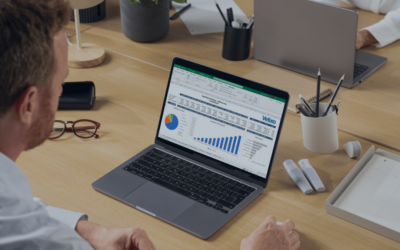One question comes up for every business conducting an ERP cost comparison. That is whether they should host their solution on-premises or go with a cloud-based solution.
On-premises enterprise resource planning ERP software, for example, comes with many advantages. Especially for companies that need more control of their data and infrastructure. Cloud, as a contrast, can be easier for small and medium sized businesses to handle in terms of ongoing management.
How do these two compare in terms of cost, though? Which is cheaper in the long run? Wondering how to perform a fair ERP cost comparison? Keep reading for the answers to this question and much more.
What is ERP and why buy one?
Before we dive into the nitty gritty of ERP pricing and how the cost of cloud vs. on premise systems differ, let’s first define exactly what we mean when we use the terms ERP, cloud ERP and on-premise ERP. Then we can begin this very important and sometimes technical discussion on an equal footing.
Don’t need a refresher? Skip ahead to the cost section of this article.
What is ERP software?
ERP software, or enterprise resource planning software, is a type of business management software that allows organizations to automate and integrate their core business processes. This can include processes such as financial management, human resources, inventory management, supply chain management, and more. The goal of an ERP system is to provide a single source of truth for all a company’s business data, helping to streamline operations, increase efficiency, and improve decision-making.
What is on premise ERP?
On-premise ERP software is a type of ERP system that is installed and runs on the company’s own hardware and infrastructure. This means that the company purchases, installs, and maintains the hardware and software, as well as managing security and backups.
On-premise ERP software typically involves a large upfront investment in both hardware and licensing fees, as well as ongoing maintenance and support costs. However, on-premise ERP software provides greater control and customization options, as well as the ability to integrate with other on-premise software and systems. (More on this in a bit).
What is cloud ERP?
Cloud ERP software is a type of ERP system that is hosted and maintained by the ERP vendors themselves, or a third-party provider. Then, users access the software over the internet.
This means that the company does not need to purchase or maintain any hardware or software. Instead, the company pays a monthly or annual subscription fee for the use of the software. This is where the term SaaS, or software as a service, comes from.
Cloud ERP software is typically more flexible and scalable than on-premise ERP software, enabling companies to add or remove users and features with ease. Additionally, it provides greater accessibility, as users can access the system from anywhere with an internet connection.
ERP Price Comparison Cloud vs. On-Premises: The Breakdown
Many believe that converting to the cloud today is easier and more affordable for a company than ever. According to Acumatica, converting to a cloud-based solution can deliver an ROI of 70%, as an example, for a company with $30,000,000 in annual revenue and 150 licensed users.
First, a Word of Caution
ERP system price comparisons between cloud and on-premises software can be like comparing apples to oranges, however. The best approach is to determine which type of software ticks the most boxes for the company’s current and future needs.
To do this, it’s important to consider the overall cost structure and weigh the advantages and disadvantages of each option. Factors ERP buyers must consider include upfront costs, ongoing maintenance and support costs, scalability, flexibility, and security and compliance requirements. Ultimately, the decision will depend the company’s unique needs and preferences.
Then, compare apples to apples. Let’s say, for example, the cloud is the business’ deployment method of choice. Perform a cloud ERP comparison, looking only at solutions that fit into that category.
ERP Cost Comparison: CapEx vs. OpEx
When considering the costs associated with ERP software, it’s important to understand the difference between capital expenses (CapEx) and operating expenses (OpEx). Capital expenses are those that are incurred in the acquisition of a long-term asset, such as hardware or software licenses, that will provide benefits to the business for several years. Operating expenses are those incurred in the day-to-day running of the business, such as salaries, rent, and utilities.
When choosing between a cloud-based ERP solution and an on-premise solution, the decision of CapEx versus OpEx can be a major consideration. Cloud-based ERP solutions typically operate on a subscription-based model, with a known rate paid each month based on the number of users. This means that the cost is an operating expense, as it is an ongoing cost that is incurred in the day-to-day running of the business.
On-premise ERP solutions typically require an upfront capital expense for hardware and software licenses. This can be a large initial investment but may be beneficial for some companies that prefer to structure their costs as capital expenses rather than ongoing operating expenses.
When doing a fair ERP cost comparison, it’s important to consider which expense structure best fits the company’s financial goals and priorities. Which is preferable? The predictability of an ongoing operating expense, or the long-term benefits of a capital expense?
Additional Considerations for Cloud and On-Premises ERP Cost Comparisons
- Subscription prices and license cost aren’t the end of the ERP cost discussion, but merely a starting point. And there aren’t necessarily strict parallels between the cost of cloud and the cost of on-premises. Both have unique structures and, therefore, bring with them different costs. Cost considerations to keep in mind include:
- ERP Implementation costs: On-premise software often requires a large upfront investment in hardware, software, and infrastructure to get started. Cloud-based solutions typically require lower upfront costs and can be implemented quickly. That said, neither on premise nor cloud ERP implementation is a DIY project. Unless a company has a deep IT bench with lots of experience working with the exact ERP package they purchase, hiring an ERP consultant is a necessity. They should act as the subject matter expert, guiding all areas of the project management process.
- Customization costs: Customizing on-premise software can be expensive and time-consuming, requiring specialized skills and knowledge. Cloud-based solutions often offer more flexible and scalable customization options, which can be more cost-effective in the long run.
- Upgrade costs: On-premise software may require costly upgrades to stay current with the latest features and security patches. Cloud-based solutions typically offer automatic updates and upgrades as part of their subscription model.
- Data migration costs: Moving data from an on-premise solution to the cloud can be a complex and costly process, requiring careful planning and execution. Talk to the company’s implementation consultant about exactly what data the company expects to migrate to the new ERP. So, the budget will include the appropriate time and money for this stage of the project, upfront. Thus, avoiding any nasty budgeting or timeline surprises.
- Training costs: Switching to a new ERP system, whether on-premise or in the cloud, will probably require staff training to ensure employees can effectively use the new software. These costs differ from system to system and depend on the type and depth of training users require. Some ERP vendors offer extensive online training materials to get new users up to speed. In other cases, ERP consultants deliver classroom style training. Both models, and a combination of them, are each a valid choice. Just be sure not to overlook this crucial step.
- Integration costs: Integrating ERP software with other systems and applications can be a significant cost consideration. Cloud-based solutions often offer more built-in integration options, reducing the need for custom integration work.
- IT Staff: On-premises will mean more in terms of IT staffing costs than a cloud-based solution. They must manage the software, plus maintain and monitor all related physical assets.
- Outage costs: What if a public cloud goes down? Would the business incur significant costs downstream? Would the business lose hours or even days of production that could harm its bottom line? Or with on-premise software, consider what would happen if a piece of critical hardware suddenly failed. Can the IT department get things back up and running fast?
- Security: Depending on the industry they work in and the regulations they must follow, certain companies must consider the long-term implications of security in the cloud. While the cloud is safer than ever, some industries demand that companies maintain a tighter control on data. In these scenarios, the large, upfront expenditure of an on-premises solution is well worth the investment.
The cost and value of cloud or on-premises ERP really changes from one business to the next. So, to perform an ERP cost comparison, the first step is to determine which type of ERP fits the company’s needs best holistically. Start exploring popular options.



